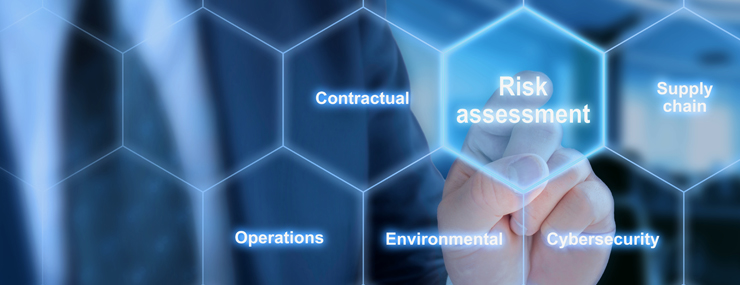- Home
- |
- Whitepapers
- |
- A Four-Step Roadmap to Complying with The GLBA Safeguards Rule
A Four-Step Roadmap to Complying with The GLBA Safeguards Rule
A Whitepaper By - Lucy Obregon, Security Architect
![]()
Financial institutions in the United States are governed by several government-established regulatory bodies designed to oversee the performance, transparency, and fairness of financial markets and their practices while protecting the interest of consumers, ensuring the confidentiality and privacy of personally identifiable information (PII), and preventing and investigating financial fraud. Amongst these regulatory bodies is the Federal Trade Commission (FTC), established on September 26, 1914, after President Woodrow Wilson enacted the Federal Trade Commission Act. The FTC’s mission is to “protect consumers and competition” and has enforcement responsibilities under several consumer protection and antitrust laws, including Title V of the Gramm-Leach-Bliley Act, entitled “Disclosure of Nonpublic Personal Information”.
The Gramm-Leach-Bliley Act, also known as the Financial Services Modernization Act of 1999, was signed into law on November 12, 1999, by President Bill Clinton, and it was designed to reform the banking industry by allowing banking institutions to offer a wide range of services to consumers, such as insurance and securities brokerage. Regarding information security, the Act mandated financial institutions implement safeguards to protect the privacy and security of non-public personal information (NPPI) about consumers. Further to that, section 504 of the Act required the FTC, along with other banking agencies and regulatory bodies, to prescribe regulations necessary for financial institutions to meet the requirements set forth by the law.
The FTC, therefore, issued the Privacy Rule on 2000 to implement the privacy requirements outlined in Title V, subtitle A of the Act concerning sharing NPPI about consumers to nonaffiliated third parties, disclosing to customers the financial institutions’ privacy policies and practices regarding information sharing with affiliated and non-affiliated third parties, and allowing customers to opt-out of having their information shared. Furthermore, the FTC enacted the GLBA Safeguards Rule in 2002 to establish standards to help financial institutions address the requirements outlined in Title V, subtitle B of the Act for financial institutions concerning the protection of NPPI about consumers through the implementation of comprehensive, risk-driven information security programs.
In 2019, the FTC proposed amending the GLBA Safeguards Rule with more specific and prescriptive security requirements for financial institutions to include in their information security program implementation. The proposed changes to the GLBA Safeguards Rule were based on New York’s Cybersecurity Regulations implemented in 2017 and addressed requirements for people, process, and technology elements that underpin any information security program. At the time of this writing, the FTC has not published an amended version of the GLBA Safeguards Rule, therefore, this paper is based on the GLBA Safeguards Rule that became effective in 2003.
This whitepaper focuses exclusively on the GLBA Safeguards Rule and examines the information security requirements for financial institutions under the FTC's jurisdiction. Furthermore, the paper outlines a four-step roadmap for financial institutions to become compliant with the Act.

The FTC published the GLBA Safeguards Rule on May 23, 2002, in response to the requirements outlined in section 504, subtitle A, title V of the Gramm-Leach-Bliley Act, which required the FTC and other federal agencies to establish standards to protect certain types of information through the implementation of administrative, technical, and physical controls. The Rule took effect on May 23, 2003, requiring financial institutions to implement a comprehensive information security program designed to protect the security, confidentiality, and integrity of NPPI about consumers. As with any information security regulation and compliance standard, understanding its applicability to your business and your scope of compliance is essential to controlling the costs associated with information security activities and remediations.
The scope of the Rule covers the handling (processing, storing, transmitting) of non-public consumers’ personal information by any financial institution under the FTC’s jurisdiction. Furthermore, the Rule defines non-public consumers’ personal information as “personally identifiable financial information” that is not publicly available and that is:
The Rule applies to financial institutions that handle NPPI, or any institution that engages in financial activities, as described in the Bank Holding Company Act of 1956, for instance, banks, car dealerships that offer loans, universities that offer student aid, payday lenders, check cashing institutions, to name a few.
While initially all financial institutions, regardless of size, were required to comply with the Rule, the 2019 proposed rule changes would exempt financial institutions with less than five thousand (5,000) costumers from most of the written requirements set forth by the Rule. Such financial institutions must still, however, comply with the basic security requirements outlined in the Rule.

The standards outlined in the first publication of the GLBA Safeguards Rule include broad and non-prescriptive security requirements that financial institutions have to meet to become compliant with the law. The standards were written in this manner to give financial institutions enough flexibility to tailor the security requirements to the needs of their business while ensuring that the Rule’s objectives are met.
The standards require financial institutions to develop, implement, and maintain a written, comprehensive, and risk-driven information security program that is appropriate to the size of the institution and includes the implementation of administrative, technical, and physical controls to protect the security, confidentiality, and integrity of NPPI about consumers. Thus, financial institutions are required to:

By definition, security is “the state of being free from danger or threat” and has been used throughout history to protect people, property, or valuable information from known threats. Similarly, organizations use physical security to protect their employees and business property, and information security to protect information from physical and cyber threats. Generally, ¬-everything about a business can be somewhat represented by information, for instance how the business operates, its strategies, and successes and failures. Furthermore, organizations across all industry sectors depend on information technology and systems to carry out their mission and business objective, and those systems need also be protected against a wide range of threats. Additionally, business information can be broadly grouped into two categories:
While organizations are responsible for establishing the requirements for protecting the confidentiality, integrity, and availability of their intellectual property and information systems, federal and state government bodies are generally responsible for establishing the requirements for protecting the privacy, security, and confidentiality of protected or regulated information and for obtaining assurance that those requirements are being met. Financial institutions are therefore accountable for implementing the requirements mandated by government bodies to protect regulated information in their custody.

In the next few sections, we will outline a roadmap to help financial institutions comply with the requirements set forth by the GLBA Safeguards Rule.

The GLBA Safeguards Rule requires financial institutions to develop a written information security program that is driven by “reasonably foreseeable internal and external risks”, but what does this mean? In essence, it means that different types of business information have different monetary values and will therefore be exposed to different types of information risks. Further to that, it means that information should be protected at levels that are commensurate with its risk profiles rather than uniformly because it is unrealistic to expect organizations to protect all of their information and systems with the same rigor. But how do we know what business information we need to protect and at what levels? With regards to regulations such as GLBA, it may seem natural to think that all NPPI must be protected at the same level. But NPPI is a broad category that covers various types of information elements, is processed by many different information systems, and is handled by various types of individuals. Applying the same level of protection to all NPPI notwithstanding the inherent risks resulting from the loss of privacy, confidentiality, or integrity of each information element could become very expensive for an organization. Hence the GLBA Safeguards Rule guidance of adopting a risk-based approach to protecting regulated information.
Information risk is the loss that an organization could endure if the confidentiality, integrity, and/or availability attributes of their information were compromised, and is often expressed as the product of two factors, including:
Or Risk = Likelihood x Impact
Information risk management is the act of weighing information risk against reward and making business decisions based on the results of risk assessments. There are various industry-accepted risk assessment methodologies that you can adopt, such as NIST SP 800-30, ISO/IEC 27005, ISF IRAM2, and most of these methodologies follow a lifecycle approach to managing information risks. You should consider all methodologies and select one that meets the long-term needs of your organization.
Before you begin developing your information security program, you should conduct an information risk assessment of your scope of regulatory compliance and use the output of the assessment to make informed decisions with regards to the activities and elements that will be included in your information security program. The output of the information risk assessment should include:

The output of Step 1 should give your organization a solid starting point to begin defining the administrative, physical, and technical safeguards, in terms of people, process, and technology, that will be required to maintain the list of prioritized residual risk profiles within acceptable levels.
The information security program should be based on a proven industry framework. By definition, a framework is a “basic structure underlying a system, concept, or text”. Therefore, an information security framework is a basic structure underlying the activities that will be performed to manage information risks within the organization’s risk appetite while improving the organization’s ability to prevent or otherwise detect and respond to attacks.
Generally speaking, a framework should contain an array of activities and desired outcomes for managing information risks and should cover all the information security domains applicable to your organization. Further to that, the framework should also consider information security requirements that your organization must adhere to due to legal or compliance mandates.
The information security framework will be underpinned by people, process, and technology elements, including:
Process:
People:
Technology:
There are several frameworks that you can choose from as a starting point to develop your own. Examples of popular information security frameworks include NIST Cybersecurity Framework (SP 800-53), Center for Internet Security Critical Security Controls (CIS), Payment Card Industry Data Security Standard (PCI DSS), or ISO 27001. You should consider using a combination of existing frameworks to develop one that is specifically tailored to your organization's realities and meets the long-term needs of your business, including your regulatory obligations.
The GLBA Safeguards Rule framework of 2003 does not prescribe the elements that must be included in the information security program. It only requires financial institutions to design and implement technical, physical, and administrative controls to manage identified risks, and it provides additional guidance concerning information risk management in the following categories:
The proposed changes to the GLBA Safeguards Rule seek to provide more prescriptive guidance with regards to the contents that financial institutions must include in their information security programs. Most of the proposed changes to the GLBA Safeguards Rules are already covered by popular information security frameworks, such as the ones mentioned earlier. Therefore, if you are already following NIST, CIS, or ISO, you are probably well underway to complying with any new changes that may be added to the GLBA Safeguards Rule in the future.

Organizations across all industry sectors partner with external suppliers, vendors, and providers of services across the globe to help execute key strategic objectives and goals. In doing so, organizations may need to entrust sensitive business and/or regulated information to third parties and/or grant third-party access to sensitive organizational information systems to achieve service agreements, thus extending their operating environment and information risk assessment scope.
Organizations that do not have a standardized methodology to consistently manage and monitor information risks as part of a procurement or supply chain process could be introducing unwanted risks that could potentially compromise the confidentiality, integrity, privacy, or availability of sensitive business or regulated information.
With regards to the GLBA Safeguards Rule, the FTC requires financial institutions to establish an external supplier risk management capability designed to identify supply chain risks and ensure that external suppliers or service providers are contractually bound to implement and maintain reasonable and suitable safeguards to protect NPPI about consumers in their custody.
To comply with this requirement, you should develop and implement an external supplier risk management capability that is integrated into your procurement or supply chain processes and is supported by:
The cyber-threat landscape is constantly changing, with new cyberattack tactics and techniques discovered almost daily. Therefore, your information security program must be continuously evaluated to ensure that the long-term needs of your business are met, that information security investments (in terms of people, process, and technology) yield the desired returns, and that information security risks are managed within your organization’s risk appetite.
The GLBA Safeguards Rule requires financial institutions to evaluate and adjust the information security program as a result of testing or when material changes to the business, cyber-threat landscape, or other circumstances impact the effectiveness of existing technical, administrative, or physical safeguards.
To comply with this requirement, you should establish a performance management process designed to evaluate the maturity and performance of your information security program based on your prioritized residual risk profiles, making adjustments as needed to maintain the desired maturity and performance level.
Defining and tracking key performance indicators (KPIs) and key risk indicators (KRIs) are common ways to provide a holistic view of the state of the information security program, allowing leadership to make data-driven decisions. KPIs are measurements that organizations use to determine how well their information security arrangements are performing against strategic goals or objectives while KRIs are metrics designed to measure risks, risk trends, and whether risks are within or above the organization’s risk tolerance level. By measuring, tracking, and reporting on the right information security KRIs and KPIs, your organizations will be able to adjust the activities of your information security program and make future investments in security using relevant and accurate data points.
Another way to measure the performance and maturity of your information security program is through information security assurance activities designed to test the effectiveness of administrative, physical, and technical security controls, processes, and procedures. Regular penetration tests, internal and external security audits against your security policies, practices, and procedures, and controls effectiveness testing are some examples of assurance activities that can provide an overview of how well your information security program is performing.

To comply with the GLBA Safeguards Rule, financial institutions are required to protect the security, privacy, confidentiality, and integrity of NPPI through the implementation of technical, physical, and administrative controls. To this end, financial institutions are required to develop, implement, and maintain a written information security program that is driven by reasonably foreseeable internal and external information risks, appoint an individual or group of individuals responsible for managing the information security program and its activities, establish an information risk management capability to identify, analyze, evaluate, treat, and monitor internal and external risks, designing and implementing adequate controls to manage identified information risks to acceptable levels, and measure the performance and maturity of the information security program.
For information security investments to deliver on their promises, information security practitioners should develop information security programs that are driven by business requirements and designed to enable the achievement of business goals and objectives. Using a top-down approach where business, legal, and compliance requirements are identified at the onset and used as inputs to identify information security risks and develop information security requirements to address those risks will ensure that your information security program can meet the long-term and wider needs of the business while also addressing legal and compliance mandates.